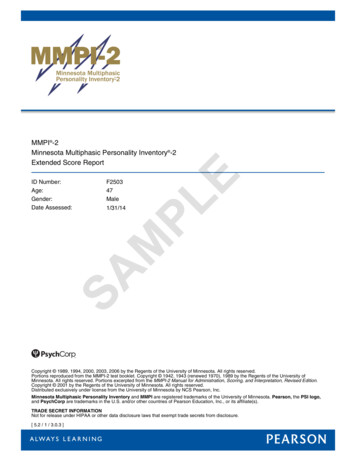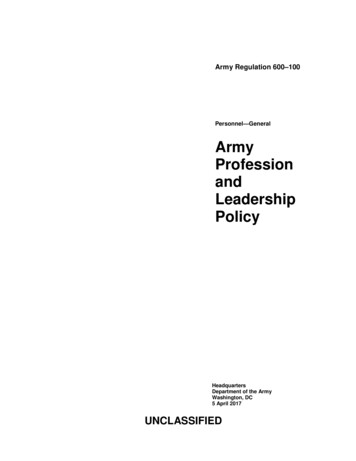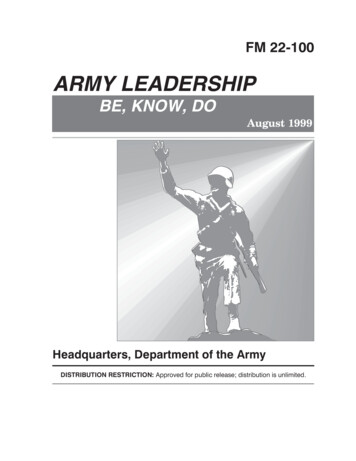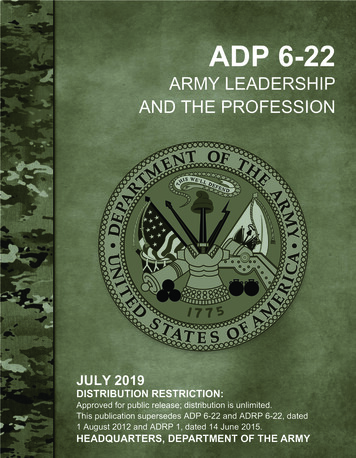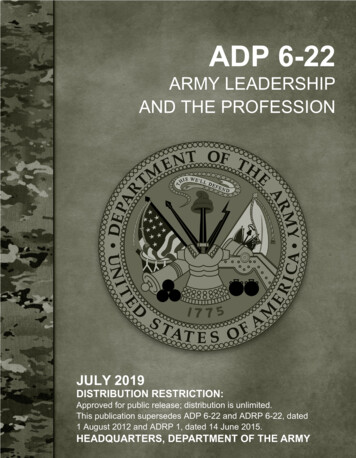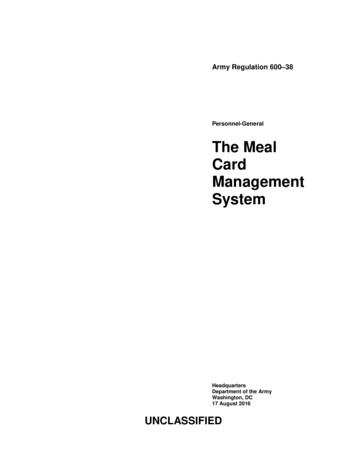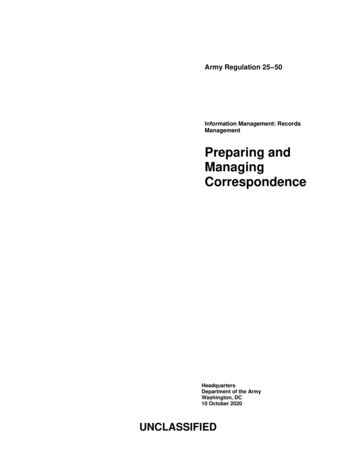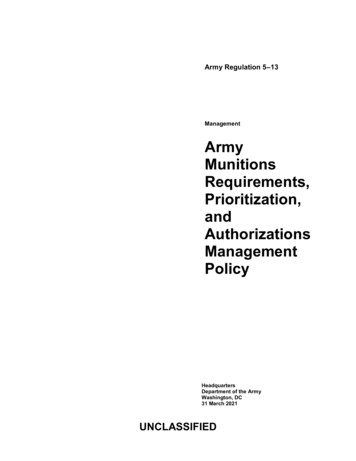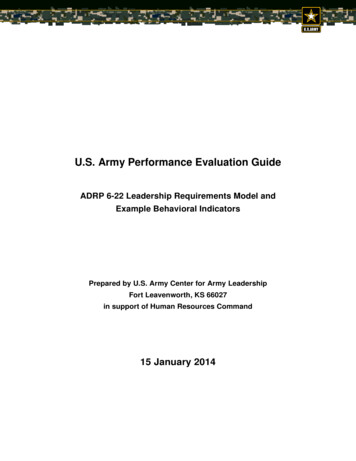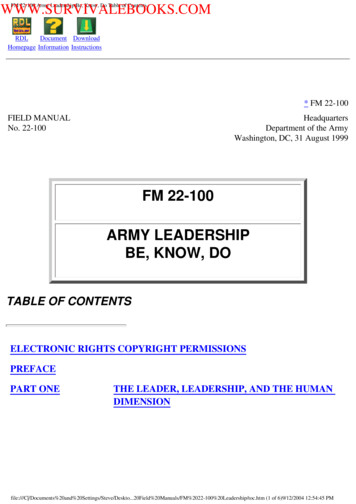
Transcription
FM 22-100 Army Leadership Be, Know, Do Table of ContentsWWW.SURVIVALEBOOKS.COMRDLDocument DownloadHomepage Information Instructions* FM 22-100FIELD MANUALNo. 22-100HeadquartersDepartment of the ArmyWashington, DC, 31 August 1999FM 22-100ARMY LEADERSHIPBE, KNOW, DOTABLE OF CONTENTSELECTRONIC RIGHTS COPYRIGHT PERMISSIONSPREFACEPART ONETHE LEADER, LEADERSHIP, AND THE HUMANDIMENSIONfile:///C 0Manuals/FM%2022-100%20Leadership/toc.htm (1 of 6)9/12/2004 12:54:45 PM
FM 22-100 Army Leadership Be, Know, Do Table of ContentsWWW.SURVIVALEBOOKS.COMCHAPTER 1THE ARMY LEADERSHIP FRAMEWORKLeadership DefinedBE, KNOW, DOLevels of LeadershipLeaders of LeadersLeadership and CommandSubordinatesThe Payoff: ExcellenceSummaryCHAPTER 2THE LEADER AND LEADERSHIP: WHAT THELEADER MUST BE, KNOW, AND DOSection ICHARACTER: WHAT A LEADER MUST BEArmy ValuesLeader AttributesFocus on CharacterSection IICOMPETENCE: WHAT A LEADER MUST KNOWSection IIILEADERSHIP: WHAT A LEADER MUST DOInfluencingOperatingImprovingSummaryCHAPTER 3THE HUMAN DIMENSIONPeople, the Team, and the InstitutionCombat StressThe Stress of ChangeClimate and CultureLeadership StylesIntended and Unintended ConsequencesSummaryPART TWODIRECT LEADERSHIPfile:///C 0Manuals/FM%2022-100%20Leadership/toc.htm (2 of 6)9/12/2004 12:54:45 PM
FM 22-100 Army Leadership Be, Know, Do Table of ContentsWWW.SURVIVALEBOOKS.COMCHAPTER 4DIRECT LEADERSHIP SKILLSInterpersonal SkillsConceptual SkillsTechnical SkillsTactical SkillsSummaryCHAPTER 5DIRECT LEADERSHIP ACTIONSInfluencing ActionsOperating ActionsImproving ActionsSummaryPART THREEORGANIZATIONAL AND STRATEGICLEADERSHIPCHAPTER 6ORGANIZATIONAL LEADERSHIPSection IWHAT IT TAKES TO LEAD ORGANIZATIONS—SKILLSInterpersonal SkillsConceptual SkillsTechnical SkillsTactical SkillsSection IIWHAT IT TAKES TO LEAD ORGANIZATIONS—ACTIONSInfluencing ActionsOperating ActionsImproving ActionsSection IIIA HISTORICAL PERSPECTIVE OF ORGANIZATIONALLEADERSHIP—GENERAL RIDGWAY IN KOREASummaryCHAPTER 7STRATEGIC LEADERSHIPfile:///C 0Manuals/FM%2022-100%20Leadership/toc.htm (3 of 6)9/12/2004 12:54:45 PM
FM 22-100 Army Leadership Be, Know, Do Table of ContentsWWW.SURVIVALEBOOKS.COMSection ISTRATEGIC LEADERSHIP SKILLSInterpersonal SkillsConceptual SkillsTechnical SkillsSection IISTRATEGIC LEADESHIP ACTIONSInfluencing ActionsOperating ActionsImproving ActionsSection IIIA HISTORICAL PERSPECTIVE OF STRATEGICLEADERSHIP—GENERAL OF THE ARMY MARSHALLDURING WORLD WAR IISummaryAPPENDIX AROLES AND RELATIONSHIPSAuthorityResponsibility and AccountabilityCommunications and the Chain of CommandThe Noncommissioned Officer Support ChannelDA Civilian SupportAPPENDIX BPERFORMANCE INDICATORSValuesAttributesSkillsActionsAPPENDIX CDEVELOPMENTAL COUNSELINGThe Leader's ResponsibilitiesThe Leader as a CounselorLeader Counseling SkillsThe Leader's LimitationsTypes of Developmental CounselingApproaches to CounselingCounseling TechniquesThe Counseling ProcessSummaryfile:///C 0Manuals/FM%2022-100%20Leadership/toc.htm (4 of 6)9/12/2004 12:54:45 PM
FM 22-100 Army Leadership Be, Know, Do Table of ContentsWWW.SURVIVALEBOOKS.COMThe Developmental Counseling FormAPPENDIX DA LEADER PLAN OF ACTION AND THE ECASPreparation of an ECASPreparation of a Leader Plan of ActionAPPENDIX ECHARACTER DEVELOPMENTAPPENDIX FTHE CONSTITUTION OF THE UNITED STATESSOURCE NOTESGLOSSARYBIBLIOGRAPHYEXAMPLESCOL Chamberlain at GettysburgSmall Unit Leader's Initiative in NormandyGEN Washington at NewburghDuty in KoreaGA Marshall Continues to ServeMSG Gordon and SFC Shughart in SomaliaWO1 Thompson at My LaiThe Will to PersevereThe Quick Reaction PlatoonGA Eisenhower Forms SHAEFSelf-Control in CombatBG Jackson at First Bull RunCharacter and PrisonersThe Battle of the BulgeGA Eisenhower's MessageThe Qualification ReportSoldiers Are Our CredentialsThe 96th Division on LeyteThe K Company VisitTask Force Ranger in Somalia, 1993Mix-Up at the Crossroads"Superior Technology"Changing a Unit Climate—The New Squad LeaderThe Checking AccountThe Rusty Rifles IncidentFinding the Real Problemfile:///C 0Manuals/FM%2022-100%20Leadership/toc.htm (5 of 6)9/12/2004 12:54:45 PM
FM 22-100 Army Leadership Be, Know, Do Table of ContentsWWW.SURVIVALEBOOKS.COMPulling Dragons' TeethThe EFMB TestTechnical Skill into Combat PowerTask Force KingstonSolving a Training ProblemAn Implied Mission and Leader Plan of ActionBrief Solutions, Not ProblemsTrust EarnedReplacements in the ETOReception on Christmas EveSGT YorkKnowing Your PeopleGEN Grant and the End of the Civil WarDA Civilian Support to Desert ShieldInnovative ReorganizationGEN Grant at VicksburgThe Commander's NotebookThe 505th Parachute Infantry Regiment at NormandyThe "Paperwork Purge"Allied Command During the Battle of the BulgeStrategic Flexibility in HaitiShow of Force in the PhilippinesCombat Power from a Good IdeaThe D-Day DecisionMultinational Resource AllocationWorld War II Strategic AssessmentChange After VietnamDISTRIBUTION RESTRICTION: Approved for public release; distribution is unlimited.*This publication supersedes FM 22-100, 31 July 1990; FM 22-101, 3 June 1985; FM 22-102, 2March 1987; FM 22-103, 21 Jun 1987; DA Pam 600-80, 9 June 1987; and DA Form 4856, June1985.file:///C 0Manuals/FM%2022-100%20Leadership/toc.htm (6 of 6)9/12/2004 12:54:45 PM
FM 22-100 Electronic Rights PermissionsWWW.SURVIVALEBOOKS.COMRDLTable of Document DownloadHomepage Contents Information InstructionsELECTRONIC RIGHTS COPYRIGHT PERMISSIONSThe copyright owners listed here have granted permission toreproduce material from their works. Other sources of quotationsand material used in examples are listed in the source notes.The quotations in Chapters 1 and 2 from Geoffrey C. Ward, The Civil War: An Illustrated History (New York: Knopf, 1990) are reprinted with permission of the publisher.PermissionsPortions of the example Task Force Kingston are reprinted from ARMY Magazine,April 1964. Copyright 1964 by the Association of the United States Army andreproduced by permission. PermissionsThe quotation by Thomas J. Jackson in Chapter 2 is reprinted from Robert D. Heinl,Dictionary of Military and Naval Quotations (Annapolis: US Naval Institute Press,1988). PermissionsThe quotation by Dandridge M. Malone in Chapter 2 is reproduced from Dandridge M.Malone, Small Unit Leadership: A Commonsense Approach (Novato, Calif.: PresidioPress, 1983). PermissionsThe quotations by Theodore Roosevelt in Chapter 5 and Dwight D. Eisenhower inChapter 7 are reprinted from John C. Maxwell, Leadership 101—Inspirational Quotesand Insights for Leaders (Tulsa, Okla.: Honor Books, 1994). PermissionsThe quotation by Arleigh Burke in Chapter 7 is reproduced from Karel Montor andothers, Naval Leadership: Voices of Experiences (Annapolis: US Naval Institute Press,1987). PermissionsExcerpts from WAR AS I KNEW IT by General George S. Patton. Copyright 1947by Beatrice Patton Walters, Ruth Patton Totten, and George Smith Totten. Copyright renewed 1975 by Major General George Patton, Ruth Patton Totten, John K. WatersJr., and George P. Waters. Reprinted by permission of Houghton Mifflin Co. All rightsreserved. Permissionsfile:///C ls/FM%2022-100%20Leadership/copyright.htm (1 of 2)9/12/2004 12:57:18 PM
FM 22-100 Electronic Rights PermissionsWWW.SURVIVALEBOOKS.COMThe quotation by George C. Marshall in Chapter 2 is reprinted from Forrest C. Pogue,George C. Marshall: Ordeal and Hope 1939-1942 (New York: Viking Press, 1966).Copyright 1965, 1966 by George C. Marshall Research Foundation. PermissionsThe quotations by Gordon R. Sullivan in Chapter 7 are reprinted from Gordon R.Sullivan and Michael V. Harper, Hope Is Not A Method (New York: Times Business,1996). Copyright 1996 by Gordon R. Sullivan and Michael V. Harper. Permissionsfile:///C ls/FM%2022-100%20Leadership/copyright.htm (2 of 2)9/12/2004 12:57:18 PM
FM 22-100 Electronic Rights Copyright Permissions 1WWW.SURVIVALEBOOKS.COMfile:///C als/FM%2022-100%20Leadership/copyright2.htm (2 of 4)9/12/2004 1:09:06 PM
FM 22-100 Electronic Rights Copyright Permissions 1WWW.SURVIVALEBOOKS.COMfile:///C als/FM%2022-100%20Leadership/copyright2.htm (3 of 4)9/12/2004 1:09:06 PM
FM 22-100 Electronic Rights Copyright Permissions 1WWW.SURVIVALEBOOKS.COMfile:///C als/FM%2022-100%20Leadership/copyright2.htm (4 of 4)9/12/2004 1:09:06 PM
FM 22-100 Electronic Rights Copyright Permissions 1WWW.SURVIVALEBOOKS.COMfile:///C als/FM%2022-100%20Leadership/copyright1.htm (2 of 5)9/12/2004 1:08:17 PM
FM 22-100 Electronic Rights Copyright Permissions 1WWW.SURVIVALEBOOKS.COMfile:///C als/FM%2022-100%20Leadership/copyright1.htm (3 of 5)9/12/2004 1:08:17 PM
FM 22-100 Electronic Rights Copyright Permissions 1WWW.SURVIVALEBOOKS.COMfile:///C als/FM%2022-100%20Leadership/copyright1.htm (4 of 5)9/12/2004 1:08:17 PM
FM 22-100 Electronic Rights Copyright Permissions 1WWW.SURVIVALEBOOKS.COMfile:///C als/FM%2022-100%20Leadership/copyright1.htm (5 of 5)9/12/2004 1:08:17 PM
FM 22-100 PrefaceWWW.SURVIVALEBOOKS.COMRDLTable of Document DownloadHomepage Contents Information InstructionsPrefaceThe Army consists of the active component, Army National Guard, Army Reserve, and Departmentof the Army (DA) civilians. It’s the world’s premier land combat force—a full-spectrum force trainedand ready to answer the nation’s call. The Army’s foundation is confident and competent leaders ofcharacter. This manual is addressed to them and to those who train and develop them.PURPOSEFM 22-100 is a single-source reference for all Army leaders. Its purpose is threefold: To provide leadership doctrine for meeting mission requirements under all conditions.To establish a unified leadership theory for all Army leaders: military and civilian,active and reserve, officer and enlisted.To provide a comprehensive and adaptable leadership resource for the Army of the21st century.As the capstone leadership manual for the Army, FM 22-100 establishes the Army’s leadershipdoctrine, the fundamental principles by which Army leaders act to accomplish the mission and takecare of their people. The doctrine discusses how Army values form the basis of character. In addition,it links a suite of instruments, publications, and initiatives that the Army uses to develop leaders.Among these are— AR 600-100, which establishes the basis for leader development doctrine and training.DA Pam 350-58, which describes the Army’s leader development model.DA Pam 600-3, which discusses qualification criteria and outlines development andcareer management programs for commissioned officers.DA Pam 600-11, which discusses qualification criteria and outlines development andcareer management programs for warrant officers.DA Pam 600-25, which discusses noncommissioned officer (NCO) career development.DA Pam 690-46, which discusses mentoring of DA civilians.The TRADOC Common Core, which lists tasks that military and DA civilian leadersmust perform and establishes who is responsible for training leaders to perform them.Officer, NCO, and DA civilian evaluation reports.FM 22-100 also serves as the basis for future leadership and leader development initiatives associatedfile:///C Manuals/FM%2022-100%20Leadership/pref.htm (1 of 6)9/12/2004 12:57:39 PM
FM 22-100 PrefaceWWW.SURVIVALEBOOKS.COMwith the three pillars of the Army’s leader development model. Specifically, FM 22-100 serves as— The basis for leadership assessment.The basis for developmental counseling and leader development.The basis for leadership evaluation.A reference for leadership development in operational assignments.A guide for institutional instruction at proponent schools.A resource for individual leaders’ self-development goals and initiatives.FM 22-100 directly supports the Army’s keystone manuals, FM 100-1 and FM 100-5, which describethe Army and its missions. It contains principles all Army leaders use when they apply the doctrine,tactics, techniques, and procedures established in the following types of doctrinal publications: Combined arms publications, which describe the tactics and techniques of combinedarms forces.Proponency publications, which describe doctrinal principles, tactics, techniques, andcollective training tasks for branch-oriented or functional units.Employment procedure publications, which address the operation, employment, andmaintenance of specific systems.Soldier publications, which address soldier duties.Reference publications, which focus on procedures (as opposed to doctrine, tactics, ortechniques) for managing training, operating in special environments or againstspecific threats, providing leadership, and performing fundamental tasks.This edition of FM 22-100 establishes a unified leadership theory for all Army leaders based on theArmy leadership framework and three leadership levels. Specifically, it— Defines and discusses Army values and leader attributes.Discusses character-based leadership.Establishes leader attributes as part of character.Focuses on improving people and organizations for the long term.Outlines three levels of leadership—direct, organizational, and strategic.Identifies four skill domains that apply at all levels.Specifies leadership actions for each level.The Army leadership framework brings together many existing leadership concepts by establishingleadership dimensions and showing how they relate to each other. Solidly based on BE, KNOW, DO—that is, character, competence, and action—the Army leadership framework provides a singleinstrument for leader development. Individuals can use it for self-development. Leaders can use it todevelop subordinates. Commanders can use it to focus their programs. By establishing leadershipdimensions grouped under the skill domains of values, attributes, skills, and actions, the Armyleadership framework provides a simple way to think about and discuss leadership.The Army is a values-based institution. FM 22-100 establishes and clarifies those values. Armyleaders must set high standards, lead by example, do what is legally and morally right, and influencefile:///C Manuals/FM%2022-100%20Leadership/pref.htm (2 of 6)9/12/2004 12:57:39 PM
FM 22-100 PrefaceWWW.SURVIVALEBOOKS.COMother people to do the same. They must establish and sustain a climate that ensures people are treatedwith dignity and respect and create an environment in which people are challenged and motivated tobe all they can be. FM 22-100 discusses these aspects of leadership and how they contribute todeveloping leaders of character and competence. These are the leaders who make the Army a trainedand ready force prepared to fight and win the nation’s wars.The three leadership levels—direct, organizational, and strategic—reflect the different challengesfacing leaders as they move into positions of increasing responsibility. Direct leaders lead face toface: they are the Army’s first-line leaders. Organizational leaders lead large organizations, usuallybrigade-sized and larger. Strategic leaders are the Army’s most senior leaders. They lead at the majorcommand and national levels.Unlike previous editions of FM 22-100—which focused exclusively on leadership by uniformedleaders at battalion level and below—this edition addresses leadership at all levels and is addressed toall Army leaders, military and DA civilian. It supersedes four publications—FM 22-101, LeadershipCounseling; FM 22-102, Soldier Team Development; FM 22-103, Leadership and Command atSenior Levels; and DA Pam 600-80 Executive Leadership—as well as the previous edition of FM 22100. A comprehensive reference, this manual shows how leader skills, actions, and concerns at thedifferent levels are linked and allows direct leaders to read about issues that affect organizational andstrategic leaders. This information can assist leaders serving in positions supporting organizationaland strategic leaders and to other leaders who must work with members of organizational- andstrategic-level staffs.FM 22-100 emphasizes self-development and development of subordinates. It includes performanceindicators to help leaders assess the values, attributes, skills, and actions that the rest of the manualdiscusses. It discusses developmental counseling, a skill all Army leaders must perfect so they canmentor their subordinates and leave their organization and people better than they found them. FM 22100 prescribes DA Form 4856-E (Developmental Counseling Form), which supersedes DA Form4856 (General Counseling Form). DA Form 4856-E is designed to support leader development. Itsformat follows the counseling steps outlined in Appendix C.FM 22-100 offers a framework for how to lead and provides points for Army leaders to considerwhen assessing and developing themselves, their people, and their organizations. It doesn’t presumeto tell Army leaders exactly how they should lead every step of the way. They must be themselvesand apply this leadership doctrine as appropriate to the situations they face.SCOPEFM 22-100 is divided into three parts. Part I (Chapters 1, 2, and 3) discusses leadership aspectscommon to all Army leaders. Part II (Chapters 4 and 5) addresses the skills and actions required ofdirect leaders. Part III (Chapters 6 and 7) discusses the skills and actions required of organizationaland strategic leaders. The manual also includes six appendixes.Chapter 1 defines Army leadership, establishes the Army leadership framework, and describes thefile:///C Manuals/FM%2022-100%20Leadership/pref.htm (3 of 6)9/12/2004 12:57:39 PM
FM 22-100 PrefaceWWW.SURVIVALEBOOKS.COMthree Army leadership levels. It addresses the characteristics of an Army leader (BE, KNOW, DO),the importance of being a good subordinate, and how all Army leaders lead other leaders. Chapter 1concludes with a discussion of moral and collective excellence.Chapter 2 examines character, competence, and leadership—what an Army leader must BE, KNOW,and DO. The chapter addresses character in terms of Army values and leader attributes. In addition, itdescribes character development and how character is related to ethics, orders—to include illegalorders—and beliefs. Chapter 2 concludes by introducing the categories of leader skills—interpersonal, conceptual, technical, and tactical—and the categories of leader actions—influencing,operating, and improving.Chapter 3 covers the human dimension of leadership. The chapter begins by discussing discipline,morale, and care of subordinates. It then addresses stress, both combat- and change-related.Discussions of organizational climate, institutional culture, and leadership styles follow. Chapter 3concludes by examining intended and unintended consequences of decisions and leader actions.Chapters 4 and 5 discuss the skills and actions required of direct leaders. The skills and actions aregrouped under the categories introduced at the end of Chapter 2.Chapters 6 and 7 provide an overview of the skills and actions required of organizational andstrategic leaders. These chapters introduce direct leaders to the concerns faced by leaders and staffsoperating at the organizational and strategic levels. Like Chapters 4 and 5, Chapters 6 and 7 groupskills and actions under the categories introduced in Chapter 2.Appendix A outlines the roles and relationships of commissioned, warrant, and noncommissionedofficers. It includes discussions of authority, responsibility, the chain of command, the NCO supportchannel, and DA civilian support.Appendix B lists performance indicators for Army values and leader attributes, skills, and actions. Itprovides general examples of what Army leaders must BE, KNOW, and DO.Appendix C addresses developmental counseling in detail. It begins with a discussion of thecharacteristics of a good counselor, the skills a counselor requires, and the limitations leaders facewhen they counsel subordinates. The appendix then examines the types of developmental counseling,counseling approaches, and counseling techniques. Appendix C concludes by describing thecounseling process and explaining how to use DA Form 4856-E, the Developmental CounselingForm.Appendix D explains how to prepare a leader plan of action and provides an example of a directleader preparing a leader plan of action based on information gathered using an ethical climateassessment survey (ECAS). The example explains how to conduct an ECAS.Appendix E discusses how Army values contribute to character development and the importance offile:///C Manuals/FM%2022-100%20Leadership/pref.htm (4 of 6)9/12/2004 12:57:39 PM
FM 22-100 PrefaceWWW.SURVIVALEBOOKS.COMdeveloping the character of subordinates.Appendix F contains a copy of the Constitution of the United States. All members of the Army takean oath to "support and defend the Constitution of the United States." It is included so it will beimmediately available for Army leaders.APPLICABILITYFM 22-100’s primary audience is direct leaders, military leaders serving at battalion level and belowand DA civilian leaders in comparable organizations. However, FM 22-100 contains doctrineapplicable at all leadership levels, to all military and DA civilian leaders of the Army.The proponent of this publication is Headquarters (HQ), TRADOC. Send comments andrecommendations on DA Form 2028 directly to Commander, US Army Combined Arms Center andFort Leavenworth, Center for Army Leadership, ATTN: ATZL-SWC, Fort Leavenworth, KS 660272300.Unless this publication states otherwise, masculine nouns and pronouns do not refer exclusively tomen.This publication contains copyrighted material.ACKNOWLEDGMENTSThe copyright owners listed here have granted permission to reproduce material from their works.Other sources of quotations and material used in examples are listed in the source notes.The quotations in Chapters 1 and 2 from Geoffrey C. Ward, The Civil War: An Illustrated History(New York: Knopf, 1990) are reprinted with permission of the publisher.Portions of the example Task Force Kingston are reprinted from ARMY Magazine, April 1964.Copyright 1964 by the Association of the United States Army and reproduced by permission.The quotation by Thomas J. Jackson in Chapter 2 is reprinted from Robert D. Heinl, Dictionary ofMilitary and Naval Quotations (Annapolis: US Naval Institute Press, 1988).The quotation by Dandridge M. Malone in Chapter 2 is reproduced from Dandridge M. Malone,Small Unit Leadership: A Commonsense Approach (Novato, Calif.: Presidio Press, 1983).The quotations by Theodore Roosevelt in Chapter 5 and Dwight D. Eisenhower in Chapter 7 arereprinted from John C. Maxwell, Leadership 101—Inspirational Quotes and Insights for Leaders(Tulsa, Okla.: Honor Books, 1994).The quotation by Arleigh Burke in Chapter 7 is reproduced from Karel Montor and others, Navalfile:///C Manuals/FM%2022-100%20Leadership/pref.htm (5 of 6)9/12/2004 12:57:39 PM
FM 22-100 PrefaceWWW.SURVIVALEBOOKS.COMLeadership: Voices of Experiences (Annapolis: US Naval Institute Press, 1987).Excerpts from WAR AS I KNEW IT by General George S. Patton. Copyright 1947 by BeatricePatton Walters, Ruth Patton Totten, and George Smith Totten. Copyright renewed 1975 by MajorGeneral George Patton, Ruth Patton Totten, John K. Waters Jr., and George P. Waters. Reprinted bypermission of Houghton Mifflin Co. All rights reserved.The quotation by George C. Marshall in Chapter 2 is reprinted from Forrest C. Pogue, George C.Marshall: Ordeal and Hope 1939-1942 (New York: Viking Press, 1966). Copyright 1965, 1966by George C. Marshall Research Foundation.The quotations by Gordon R. Sullivan in Chapter 7 are reprinted from Gordon R. Sullivan andMichael V. Harper, Hope Is Not A Method (New York: Times Business, 1996). Copyright 1996by Gordon R. Sullivan and Michaelfile:///C Manuals/FM%2022-100%20Leadership/pref.htm (6 of 6)9/12/2004 12:57:39 PM
FM 22-100 Part One The Leader, Leadership, and the Human DimensionWWW.SURVIVALEBOOKS.COMRDLTable of Document DownloadHomepage Contents Information InstructionsPART ONEThe Leader, Leadership, and the Human DimensionThere are two reasons why leadership is important to you and to the Army. The first was expressedeloquently by General of the Army Douglas MacArthur in a 1962 speech. GA MacArthur spokeabout what he had learned about soldiering and service in a career that spanned more than fifty yearsand two world wars. He distilled the lessons gathered from "twenty campaigns, on a hundredbattlefields, around a thousand campfires" into a few words that are as true now as they ever were:[Y]our mission is to win our wars [Y]ou are the ones who are trained to fight. Yours is theprofession of arms, the will to win, the sure knowledge that in war there is no substitute forvictory; that if you lose, the nation will be destroyed.Make no mistake about it. GA MacArthur is speaking to you as you sit in your classroom, as you readthis in the dayroom or the motor pool or at the kitchen table. You are the Army’s leaders, and on yourshoulders rests this mission: win our wars. The desire to accomplish that mission despite all adversityis called the warrior ethos and makes the profession of arms different from all other professions. Thatethos applies to all soldiers, not just those whose job it is to find, fight, and defeat the enemy. You’llread more about it in Chapter 2.If that were not enough, there is a second reason you must strive to become the very best leader youcan be: your people deserve nothing less. When you took your oath, when you agreed to be a leader,you entered into a pact with your subordinates and your nation. America has entrusted you with itsmost precious resource, its young people. Every person serving with you is someone’s son orsomeone’s daughter, a brother, mother, sister, father. They are capable of extraordinary feats ofcourage and sacrifice—as they have proven on GA MacArthur’s hundred battlefields and on everybattlefield since then. They are also capable of great patience and persistence and tremendous loyalty,as they show every day in thousands of orderly rooms and offices, in tank parks and on firing rangesaround the world. They show up and they do the work, no matter how frightening, no matter howboring, no matter how risky or bloody or exhausting. And what they ask in return is competentleadership.The most precious commodity with which the Army deals is the individual soldier who is theheart and soul of our combat forces.file:///C anuals/FM%2022-100%20Leadership/part1.htm (1 of 2)9/12/2004 12:58:02 PM
FM 22-100 Part One The Leader, Leadership, and the Human DimensionWWW.SURVIVALEBOOKS.COMGeneral J. Lawton CollinsVII Corps Commander, World War IIYou have been entrusted with a great responsibility. How do you prepare yourself? How do you learnand embrace those values and skills that will enable you to meet the challenge?This manual is a tool to help you answer these questions, to begin or continue becoming a leader ofcharacter and competence, an Army leader. Chapter 1 starts with an overview of what the Armyrequires of you as an Army leader. This is the Army leadership framework; it forms the structure ofthe Army’s leadership doctrine. Chapter 1 also discusses the three levels of Army leadership: direct,organizational, and strategic. Chapter 2 discusses character, competence, and leadership—what youmust BE, KNOW, and DO as an Army leader. Chapter 3 talks about the human dimension, the manyfactors that affect the people and teams that you lead and the institution of which you and they are apart.file:///C anuals/FM%2022-100%20Leadership/part1.htm (2 of 2)9/12/2004 12:58:02 PM
FM 22-100 Chapter 1 The Leadership FrameworkWWW.SURVIVALEBOOKS.COMRDLTable of Document DownloadHomepage Contents Information InstructionsCHAPTER 1The Army Leadership FrameworkJust as the diamond requires three properties for its formation—carbon, heat, and pressure—successful leaders require the interaction of three properties—character, knowledge, andapplication. Like carbon to the diamond, character is the basic quality of the leader. But ascarbon alone does not create a diamond, neither can character alone create a leader. Thediamond needs heat. Man needs knowledge, study, and preparation. The third property,pressure—acting in conjunction with carbon and heat—forms the diamond. Similarly, one’scharacter, attended by knowledge, blooms through application to produce a leader.General Edward C. MeyerFormer Army Chief of Staff1-1. The Army’s ultimate responsibility is to win the nation’s wars. For you as anArmy leader, leadership in combat is your primary mission and most importantchallenge. To meet this challenge, you must develop character and competence whileachieving excellence. This manual is about leadership. It focuses on character,competence, and excellence. It’s about accomplishing the mission and taking care ofpeople. It’s
Chapter 7 are reprinted from John C. Maxwell, Leadership 101—Inspirational Quotes and Insights for Leaders (Tulsa, Okla.: Honor Books, 1994). Permissions The quotation by Arlei
